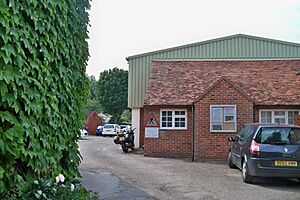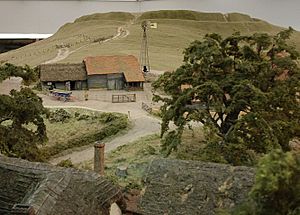Pendon Museum facts for kids
 |
|
| Lua error in Module:Location_map at line 420: attempt to index field 'wikibase' (a nil value). | |
| Established | 1954 |
|---|---|
| Location | Long Wittenham, Oxfordshire, England |
| Type | History museum |
| Founder | Roye England |
The Pendon Museum is a special place in Long Wittenham, near Didcot, Oxfordshire, England. It's a museum filled with amazing scale models. These models are like tiny, perfect copies of real things.
The main display is a huge scene showing parts of the Vale of White Horse area. This model shows how the area looked in the 1920s and 1930s. Building this scene started in the 1950s. It took a lot of careful research to make the buildings and landscape look just right. Some tiny model cottages took hundreds of hours to finish!
The museum was started by Roye England, an Australian artist who loved England. He worked with Guy Williams, a talented English model maker. Guy Williams built 57 of the museum's 90 model trains! You can even see them working together in an old film from 1958 called 'Hair Thatching'.
Today, a group of volunteers keeps the museum running. It's usually open on weekends and holidays, except in winter. It also opens on Wednesdays during school holidays.
Contents
How Pendon Museum Started
The Pendon Museum was founded by Roye England. He was an artist and craftsman who loved model railways. Roye noticed that many old buildings in the area were being changed or even destroyed. He wanted to save their memory.
So, he started making tiny, exact models of these historic buildings. This way, people could still see how they looked. The museum's main display, the Vale of White Horse scene, shows working model trains. These trains are detailed copies of those that ran on the Great Western Railway (GWR) in the 1920s.
Exploring the Displays
The Pendon Museum has several amazing model displays. Each one shows a different part of England or a different railway scene.
The Vale of White Horse Scene
This is the biggest and most important display at Pendon. It's a huge model of the Vale of White Horse area from the time between World War I and World War II. The scene includes a "typical" village called Pendon Parva.
This village has a railway station on the main London to Bristol GWR line. It also has another station from the M&SWJR. While the village layout is made up, every single building and feature is a perfect model of a real building from the Vale of White Horse.
Here are some of the model trains you can see on this layout:
- GWR 2900 Class No. 2943 Hampton Court (built in 1912)
- GWR 4000 Class No. 4050 Princess Alice (built in 1914)
- GWR 2251 Class No. 2253 (built in 1930)
- LSWR N15 Class No. 789 Sir Guy (built in 1925)
- GWR 3700 Class No. 3705 Mauritius
- LSWR S15 class No. 515 (built in 1921)
The Dartmoor Railway Scene
On the ground floor of the museum, there's another model. It shows a Great Western Railway branch line on Dartmoor. This model was first built in 1955. It was made to show off the trains that were being built for the larger Vale scene.
A key part of the Dartmoor scene is a model of Brunel's wooden viaduct at Walkham in Devon. This viaduct model was built by R. Guy Williams. He also built many of the model trains you see at the museum.
Some trains on the Dartmoor layout include:
- GWR 2900 Class No. 2921 Saint Dunstan (built in 1907)
- GWR 2800 Class No. 2844 (built in 1912)
- LSWR M7 Class No. 30 (built in 1904)
The Madder Valley Railway
The museum also has displays of individual models and shows how models are made. You can also see Madder Valley, which is a very important and early model railway. It was built by John Ahern.
About the Models
The model trains at Pendon Museum are all built by hand. They are made to look exactly like real locomotives, carriages, and wagons. The model makers use old records and photographs to get every detail right.
When you visit, you'll see a sequence of trains running. This shows what you might have seen passing by on a summer day or night in the mid-1920s. This sequence is based on the actual train timetables from that time. All the models are built to a scale of 4 millimeters to 1 foot (1:76). They run on tracks that are 18mm wide. This specific combination is known as EM gauge.




